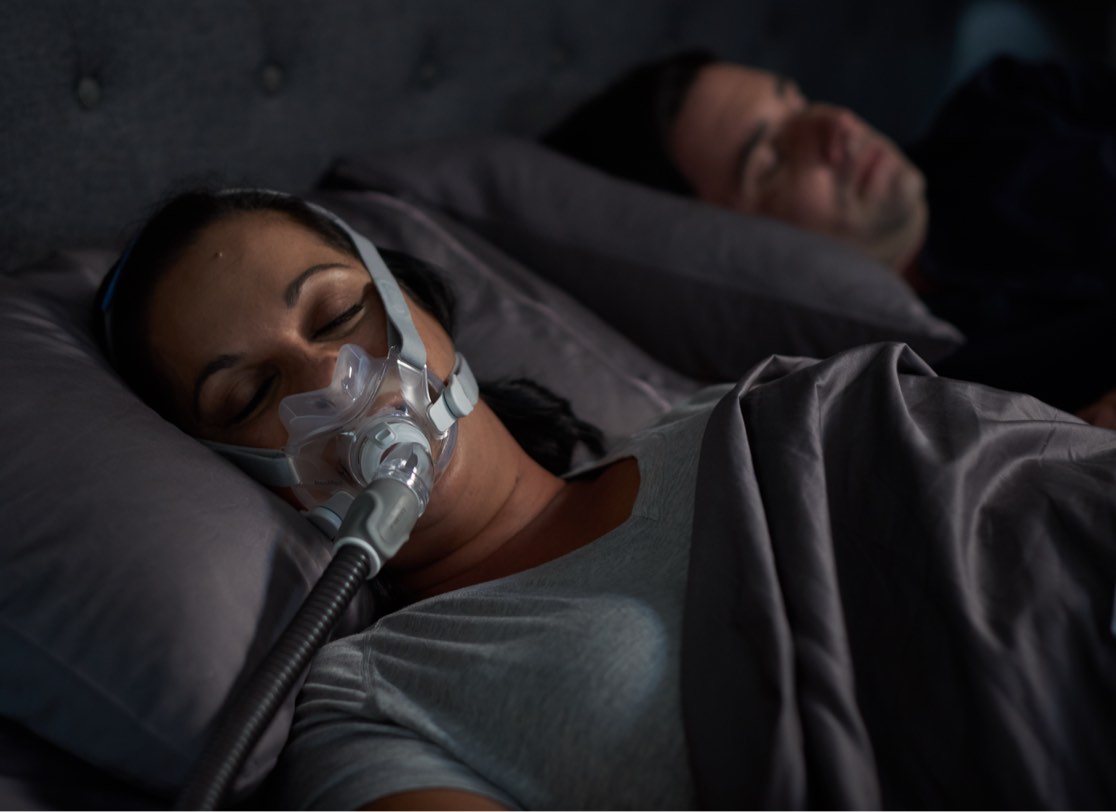
CPAP stands for ‘continuous positive airway pressure’.
If you’ve been diagnosed with sleep apnea, your doctor may recommend that you use a CPAP machine. CPAP machines have been treating sleep apnea for over 30 years.1
CPAP delivers a constant flow of air via a mask while you sleep, helping to keep your airway open.
A machine with a motor to compress air from your room. A CPAP machine delivers filtered room air. Many CPAP machines have heaters and built in water tanks, so that the air you breathe can also be heated and humidified, which makes it more comfortable.
A mask which you fit over your face. There are many different sizes and shapes of masks to choose from and it’s important to select the one that’s right for you.
A tube which connects the CPAP machine to the mask. Many tubes have built-in heaters to help prevent the heated, humidified air from condensing inside.

There are 3 main types of CPAP masks
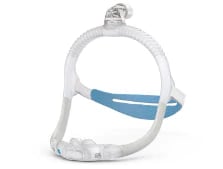
Nasal pillows masks are very small and lightweight. They snuggle against your nostrils. They’re popular because of their minimal design and are a good choice if you tend to be claustrophobic. You can read and wear your glasses while wearing a nasal pillows mask. If you move about a lot when you sleep, this may be a good mask for you.
Nasal pillows masks aren’t so good for people who need higher air pressures or people who tend to breathe through their mouth. But if you are a mouth breather, you can still try one and add a chin strap to help keep your mouth closed.
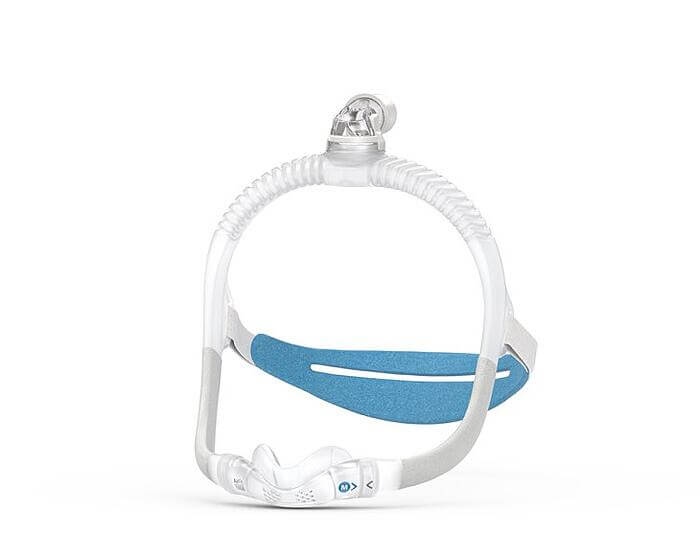
Nasal masks fit over your nose and provide a slightly more indirect pressure compared to a nasal pillows masks. They’re better for people who need higher pressures and there’s a good range of sizes to choose from.
Nasal masks, like nasal pillow masks aren’t ideal for mouth breathers unless you add a chin strap. Some people find the nasal mask irritates the bridge of their nose. If you often get a blocked nose, you may have trouble with a nasal or nasal pillows mask.
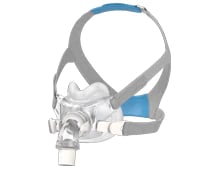
Full face masks cover your mouth and nose, and are a good choice if you’re a mouth breather, if you frequently get a blocked nose or if you need higher pressure.
Look for a full face mask that had a good fit. This will prevent leaking air, especially near your eyes (giving you dry eyes). Newer styles of full face masks may allow you to wear glasses, read without too much obstruction. It may be harder to sleep on your stomach while wearing a full face mask.

Your choice of CPAP mask is the most critical aspect of ensuring that your CPAP therapy is successful. Choosing a comfortable CPAP mask can help to ensure that you use your therapy regularly and enjoy a comfortable night’s sleep.
When choosing a CPAP mask, think about the shape of your face, whether you have facial hair and whether you’re claustrophobic at all. When you’re looking at masks, try on as many types and sizes as you can, so you can find one you like best.
CPAP masks do wear out and need to be replaced regularly.

APAP which stands for ‘automatic positive airway pressure’. These devices work like CPAP but the pressure they deliver varies depending on your needs, which can make treatment feel more comfortable.
%20copy.png?width=221&height=120&name=resmed-lumis-vpap-s__53731.1512361695%20(1)%20copy.png)
Bi-level machines are more advanced types of devices mainly used by people with more severe respiratory problems.
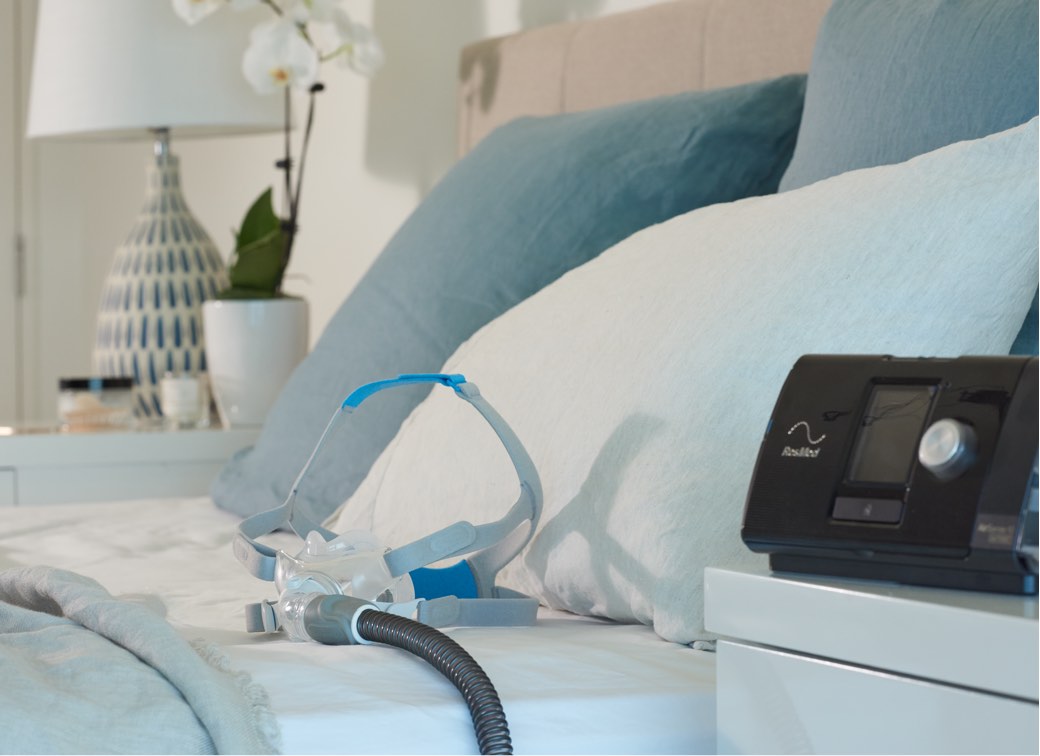
Both CPAP and bi-level therapies are effective and the machines look much the same. Bi-level machines delivers a lower pressure when you’re breathing out. They’re often preferred by people who need higher pressures, and a lower pressure when breathing out makes it easier to exhale. They are also used by people with other respiratory problems such as congestive heart failure, lung disease or a neuromuscular disorder.
Bi-level machines are more expensive than regular CPAP machines.
There is quite a large range of CPAP machines available in Australia.
Features to look for include:
To prevent drying of your airways. Most new machines have built-in humidifiers. Some have ‘waterless humidification’ which supplies humidified air without the need for a water tank.
When you start up your CPAP machine for the night and put on your mask, it can feel a bit strange, having air flowing down your throat, so some machines have a ramp feature which gradually builds up to your prescribed pressure. Some CPAP machines will only ramp up the pressure after they’ve detected that you’ve fallen asleep. This feature is called ‘Auto-Ramp™’.
Machines with this feature reduce the pressure as you breathe out which makes breathing out feel easier and more natural.
If your mask comes loose or starts leaking air when you’re asleep, this feature will sound an alert.
If your mask leaks, a CPAP machine with this feature will increase the flow of air so that you’re still getting the right amount.
Devices with a smartphone app can be set up, controlled and adjusted via your smartphone. The app can also show you how well you slept and whether you had any events during the night.
Many newer CPAP machines can record sleep information. Some machines upload the data to a SIM card that you can give to your sleep consultant who can use it to analyse your progress. Others have Wi-Fi capability which enables your consultant to remotely monitor your progress and even make adjustments remotely to refine your therapy.
Women tend to have different sleep apnea patterns to men. There are now CPAP machines designed specifically for women to deliver therapy using algorithms that are more sensitive to a woman’s needs.
To begin with, it will help to stop your snoring, making sleep easier your partner and other family members. Successful therapy means you can look forward to more restful, less disturbed sleep and waking up with more energy, alertness and focus to enjoy your day. Then there are the added benefits: improved mood, libido and reduced blood pressure.5
CPAP therapy has been used for treating obstructive sleep apnea since 1981. During this period, night time, daytime and long term health benefits have been proven in multiple clinical studies.6
The main adverse effects that people mention from CPAP therapy are skin irritation from the mask, as well as dry eyes, nasal congestion and airway dryness from the air. Most people will tell you that the most difficult part of CPAP therapy is getting used to using it initially. You’ll need time and patience to adapt to CPAP, but you should start to notice the benefits within 2 weeks of using it all night.7
There are several different types of sleep test for obstructive sleep apnea. A sleep test will determine whether you actually have sleep apnea and if so, your doctor may prescribe CPAP.
The best CPAP machine is one that works well for you (and your budget). Your sleep consultant will explain your options, depending on the type and severity of your sleep apnea, as well as your personal preferences.
Advancements in technology have enabled us to design machines that are much quieter than older model machines. Take a look at what's new in our online shop.
Yes, you definitely can and should take your CPAP machine with you when you travel. Lightweight machines are easier to travel with and the machines with a universal power supply can be used all over the world. If you’re sleeping on a plane, you need to ask the airline in advance for approval to use it on the flight. Make sure you can sit near a power source.
Carry a letter from your doctor that certifies your need for CPAP. If you're traveling with a ResMed device, we also recommend that you also carry a copy of this FAA compliance letter.
Make sure you have the right power adaptor for your destination. Pack an extension cord in case your hotel doesn’t have a power point near your bed.
If your CPAP machine has a humidifier that contains water, don’t use the humidifier on your flight as water could spill out and damage your machine.
A CPAP machine works by helping to prevent your airway from collapsing while you sleep. This can reduce or eliminate snoring, insomnia, and night time bathroom visits so you and those around you can enjoy a more restful night’s sleep.
The right CPAP pressure depends on your individual needs. Your treatment must be individually titrated to suit your needs while providing you with a comfortable night’s sleep.
You can buy a CPAP machine without having a sleep test but it’s not recommended. In the first place, you can’t be sure you have sleep apnea without getting a sleep test. Secondly, you won’t know how severe your sleep apnea is, what type it is or how to titrate your machine to suit your needs.
You can easily get a home sleep test and receive your diagnosis without the bother of having to spend a night in a sleep lab. If the sleep test indicates that you do have sleep apnea, you can simply order a CPAP trial so you can trial a machine and mask before you buy. Easy!
You can use your CPAP machine without a humidifier however the humidifier is designed to make treatment more comfortable by warming and humidifying the air you breathe while you sleep. Without a humidifier, you may notice that your airways become dry, but the treatment will still work.
You should start to feel the benefits of improved sleep in terms of increased daytime awakeness, higher energy levels and enjoyment of life within 2 weeks of using CPAP therapy.10
If you’re only using it for a few hours a night at first (like many people do), you may not notice the benefits as quickly. Once you get used to it and use it for more hours per night, you should see the benefits increase.
CPAP machine prices vary depending on the type of machine and its features. In Australia, you can pay around $1,100 for a basic new machine. CPAP machine with all the latest features may cost more. Check if the cost of your chosen mask is included in the price.
In Australia CPAP masks vary in cost ranging between $200 and $300 depending on the type and brand. You should always buy a new (not second hand) mask for hygiene reasons. Make sure your chosen mask is compatible with your CPAP machine.
Here are 2 tips for choosing the right mask:
If your mask is leaking something’s wrong. First, check the user guide that came with your mask. A mask may leak because it’s adjusted incorrectly, put together incorrectly or it’s the wrong size for you. If the mask fitted before and has recently started leaking, maybe its worn out and you need to replace it. They don’t last forever.
CPAP machines are only covered by Medicare for people who have a Pension Concession Card, a Commonwealth Seniors Health Card, or a Health Care Card.
If you have extras cover, your private health insurance may pay a rebate towards the cost of your CPAP machine. The amount varies considerably between funds and also depends on your level of extras cover. Some funds will also cover part of the cost of the mask. Some funds require a letter of recommendation from your doctor. All require an eligible invoice.8
Check with your health fund to get an accurate and up to date quote for the amount they will cover.
Source: https://www.resmed.com/au/dam/documents/articles/clinical_newsletter/resmedica14.pdf accessed 7 August 2019.
Source: https://www.sleepfoundation.org/articles/cpap-treating-sleep-apnea accessed 2 Aug 2019.
Source: https://www.sleepassociation.org/sleep-treatments/cpap-machines-masks/cpap-vs-bipap/ Accessed 12 June 2019.
Source: http://sleepeducation.org/essentials-in-sleep/cpap/benefits Accessed 12 June 2019.
Source: Fatureto-Borges F et al. Integr Blood Press Control. 2016; 9: 43–47.
Source: Tingting, X et al. 2017.European Archives of Oto-Rhino-Laryngology, 275(2), 335–346.
Source: https://www.sleepfoundation.org/articles/sleep-and-cpap-adherence Accessed 12 June 2019.
Source:https://apneaseal.com.au/australian-health-fund-rebates/ Accessed 12 June 2019.